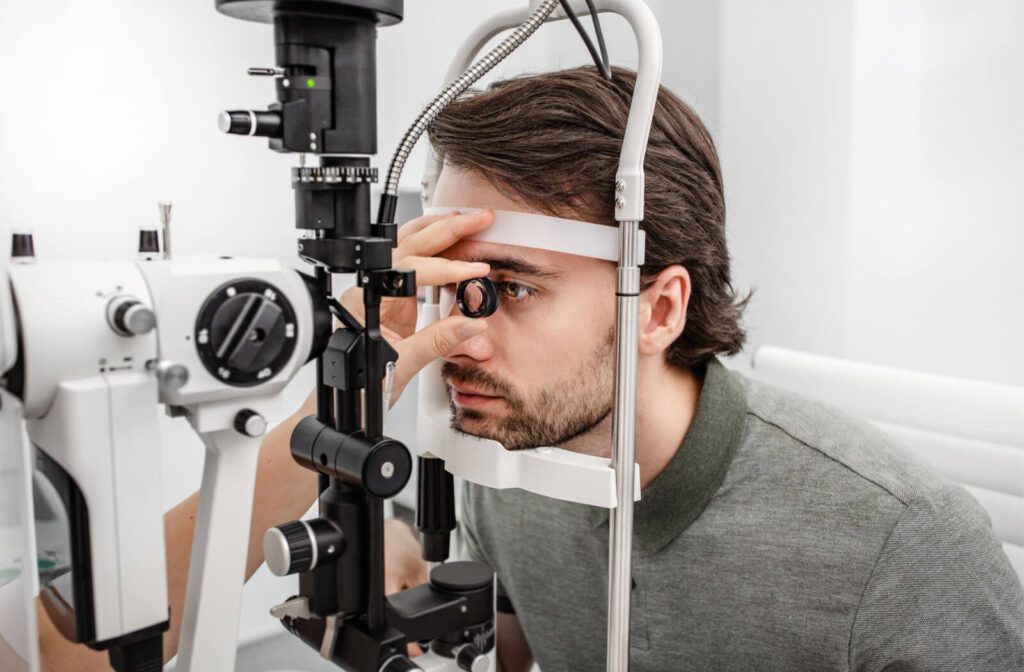Table of Contents

Introduction
Childhood is when we experience some of our biggest changes, like moving up shoe sizes or adding new marks on a height chart. Growth is a normal part of our younger years, including eye growth.
Eye shape and size can impact our vision, so it’s unsurprising that vision problems like myopia are usually diagnosed in childhood–when eyes are still growing. Yet, vision can change throughout our lives.
Our sight can worsen as we age, and some forms of myopia can lead to vision-threatening conditions.
What Is Myopia?
Myopia, also called nearsightedness or shortsightedness, is a vision condition resulting in blurry distance vision. Myopia is caused by an irregular eye shape, either a too-long eye (lengthwise) or a too-steeply curved cornea. The length makes it difficult for light to reach the retina, the light-sensitive tissue at the back of the eye.
Myopia is commonly diagnosed in childhood, between ages 6–14. The condition worsens until eye growth stabilizes by a person’s early 20s. However, late-onset myopia can develop in adulthood, with progression into a person’s 30s. This can be especially for people of Asian descent.
Nearsightedness is one of the most common vision problems, affecting nearly 30% of the U.S. population. Unfortunately, it’s also on the rise worldwide, with researchers predicting 50% of the global population will be myopic by 2050.
High vs. Low Myopia
How much your vision is impaired can depend on whether you have low, moderate, or high myopia.
- People with low myopia experience minor symptoms. They may not use prescription lenses or use them infrequently.
- People with moderate to high myopia can experience moderate to severe symptoms. They may wear prescription lenses throughout the day. Or, they may have too high a prescription for standard eyeglasses or contact lenses.
Average visual acuity is measured as 20/20 vision (what the average person can see clearly from 20 feet away). High myopia is usually considered about 20/200 or worse. So, for example, someone with high myopia (20/200) needs to be 20 feet away to see what the average person can see 200 feet away.

Degenerative Myopia
People with moderate to high myopia have a greater risk of developing sight-threatening conditions. Myopia is a progressive condition. When the eye continues to grow, it can deteriorate eye tissue (known as myopic macular degeneration).
High myopia can also lead to an increased lifetime risk of cataracts, glaucoma, and retinal detachment.
Cataracts
A cataract develops from broken-down protein in the eye’s lens. The proteins form clumps or spots, affecting the lens’ flexibility and blocking light. As a result, the normally clear lens can look cloudy or turn yellowish-brown. When untreated, cataracts can cause blindness.
Cataracts are associated with adults over 55, as the lens becomes more rigid around age 40. Unfortunately, pathological myopia can lead to cataracts earlier in life. Additionally, people with high myopia are 3 times more likely to develop a nuclear cataract (center of the lens) and nearly 8 times more likely to develop a posterior subcapsular cataract (back of the lens).
Glaucoma
People with glaucoma experience optic nerve deterioration. The optic nerve transmits vision through electrical signals to the brain. When nerve tissue is lost, it decreases vision, with progressive deterioration resulting in blindness.
Glaucoma is typically caused by fluid buildup and increased eye pressure, gradually damaging the nerves.
High myopia can change eye tissue, including making the eye less tolerant of pressure changes. As a result, a person with high myopia may have a greater risk of optic nerve damage with less significant eye pressure increase.
Retinal Detachment
The retina uses light properties to detect visual information, like color or depth. Unfortunately, the tissue is delicate and can be dislodged from the back of the eye because of injuries or eye disease.
Myopia progressive results in continued eye growth, stretching eye structures like the retina. The retina can tear or pull away from the back of the eye, leading to retinal detachment. The damage or detachment can impair vision.
Retinal detachment can also cause flashes of light, floaters or spots, and loss of central vision.
Myopia Control
Myopia can worsen as the eye grows, leading to eye conditions developing in adulthood. Myopia control helps manage eye growth in childhood to protect vision throughout their lives.
Atropine Eye Drops
Optometrists can prescribe low-dose atropine eye drops to slow myopia progression. Atropine relaxes the eye’s focusing mechanisms, resulting in slowed eye growth. Eye dilation can last up to 4–6 hours after the eye drops are used and can cause temporary light sensitivity or blurry vision.
Multifocal Contact Lenses
Multifocal contact lenses help slow eye growth by correcting how peripheral light rays focus inside the eye. As a result, the lenses improve distance vision and help prevent worsening myopia.
MiSight 1 Day lenses are the first FDA-approved multifocal contact lenses for myopia control in children. The lenses are disposable soft contact lenses, and many children can feel comfortable using and wearing their lenses.
Orthokeratology
Ortho-k (orthokeratology) uses rigid gas permeable (RGP) contact lenses to reshape the cornea (front of the eye). The lenses are worn at night and removed in the morning. As a result, children experience clear vision throughout the day. Additionally, ortho-k can help slow myopia progression by nearly 50%.
Visit Us for a Consultation
Nearsightedness typically stops worsening by adulthood, but it can cause progressive vision changes throughout a person’s life. You can protect your child’s sight with myopia control. Our doctors at Golden Vision are passionate about myopia control.
Book an appointment today, so we can start your child’s personalized treatment plan.

